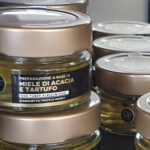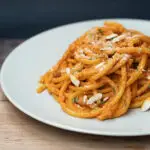Italians have been well known for their excellent-tasting foods. For this reason, knowing their secret has been long sought for years. Is cooking in extra virgin olive oil the secret to delicious Italian cuisine?

A big yes would be the answer here! Italians are very fond of extra virgin olive oil for various low-heat and slow-cooking recipes, including pasta sauces and casseroles. Besides the oil’s ability to add a unique flavor to the food, it has numerous health benefits with regular consumption, making it one of the best cooking oils.
The article below mentions details of everything you need to know about cooking in extra virgin olive oil. Read on!
Do Italians Cook with Extra Virgin Olive Oil?
Italians very commonly use extra virgin olive oil for cooking different recipes. Since pasta and casseroles are an Italian favorite, using olive oil in making the base sauces is very common and often preferred to other oils. Not only is it used for cooking, but olive oil is also used as a special seasoning to replace butter or sesame oil.
Italians use olive oil almost exclusively because it can give any dish its distinctive flavor and subtleties. For this reason, it is frequently used raw to season prepared foods like pasta, pizza, salads, pieces of meat, and many other foods.
Some Italians use extra virgin olive oil only for cooking and prevent its use in frying since the process requires a rather generous amount of oil, keeping the purchase costs in mind. Others, however, opt for the pricier product mainly because of its health benefits; the oil does not significantly reduce its antioxidant content when exposed to heat.
While properly prepared extra virgin olive oil loses part of its nutritional value, it doesn’t become unhealthy or calorie-dense. This, in turn, allows the consumer to enjoy the rich flavor and avoid any possible cardiac health issues.
Foods Best Cooked in Olive Oil
Most Italian cuisines use a drizzle or more of extra virgin olive oil, while some use it as an essential ingredient for making the base of a dish. The list below mentions some food items that use this olive oil and the simple steps to make them.
Spaghetti: Spaghetti with chili, garlic, and olive oil is a simple dish that tastes divine. The steps include:
- Boil the spaghetti (400 grams) in salted water until it is done.
- Heat the olive oil (200 ml) in a pan; add three cloves of garlic. After stirring for 2-3 minutes, add parsley and chili (1 finely chopped) with two tablespoons of pasta water. Stir the sauce and simmer for 3 minutes.
- Add the drained spaghetti to the sauce and toss until it is well incorporated. Serve fresh and hot.
Olive Oil Biscuits: These Italian biscuits are made with extra virgin olive oil to replace butter, and they taste delicious!
- Combine lemon zest (of 1 lemon), sugar (300 grams), vanilla (1 pod), and olive oil (230 ml) in a bowl. Then, add sifted flour (330 grams), salt (a pinch), and bicarbonate of soda (1 teaspoon) and thoroughly combine. Allow the dough to rest for 24 hours.
- Set the oven to 170°C (340°F) or gas marks 3 or 4. The dough should be formed into little balls, slightly pressed flat, and baked for 8 to 10 minutes or until golden brown. Remove from the tray and allow them to cool. Enjoy!
Extra Virgin Olive Oil Brands
Given the huge range of companies that produce extra virgin olive oil, finding the best oil available in Italian stores can be very challenging.
The research was nationally performed to find the best extra virgin olive oils for supermarket purchases in 2021. The results are presented in the list below.
- Monini Bios: Produced in Italy, this brand offers 100% organic olive oil. Bios has a particularly lovely, strong aroma of fresh grass, and it tastes sweet with a hint of bitterness and spice. For raw condiments, this Premium Organic Extra Virgin Olive Oil is great. It ranks first for the best Extra Virgin Olive Oil produced in Italy and is available for $12.
- Clemente la Terra dell olio: This 100% Italian product ranks second in Italian produced Extra Virgin Olive Oil. It has almost the same qualities as the Bios and is available at a cheaper price of $10.
- Carapelli Bio: Ranking in the third position, the Carapelli Bio oil has simple notes of green leaves and vegetables that are tastefully complemented by more bitter and spicy overtones. The oil’s refined blend is created by flawlessly blending four different types of olives. It pairs beautifully with fish and vegetables and can be bought for $8.70.
Extra Virgin Olive Oil and Digestion
Extra virgin olive oil is famously known to help the digestive system by lowering the possibility of acid reaction by stopping stomach juices from rising to the throat. As a result, the gastric contents of the stomach pass more gently and slowly into the intestine, increasing satiety, enhancing digestion, and facilitating the complete absorption of nutrients in the intestine.
Consequently, this prevents the buildup of cholesterol and unhealthy fats in the blood vessels, significantly lowering the risk of heart attacks.
Precautions for Using Olive Oil for Cooking
The only time extra virgin olive oil is not suitable for cooking is when deep frying is involved. Cooking oils have a maximum heating point called the smoke point, at which oils produce a blue flame that is seen with the naked eye. Olive oil reaches this point at 190°C-215°C (374°F – 419°F), which is close to the temperature for deep frying; hence this is not suitable for such purposes.
Conclusion
Extra virgin olive oil has changed the game of everyday cooking, not just in Italian but also in Greek, Mediterranean, and Spanish cuisine. It offers an easy, healthy, and flavorful solution to shallow fry and quick-stirs while also serving as the missing good luck charm for salads and quick-drizzle recipes. For heart patients in particular, the oil allows easy eating without the fear of health, simultaneously allowing easy digestion and preventing over-eating.
- The Top Restaurants Specializing in Truffle Dishes - August 10, 2023
- Truffle Panna Cotta: A Decadent Dessert Recipe for Truffle Lovers - August 7, 2023
- Truffle Scrambled Eggs: A Luxurious Breakfast Delight - August 7, 2023








